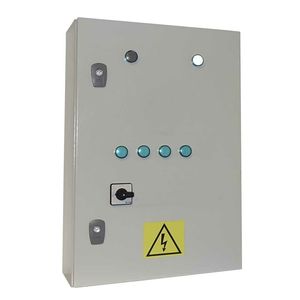
- Products
- Airport control cabinet
- Signalight
- Company
- Products
- Catalogs
- News & Trends
- Exhibitions
Airport control cabinet AL-OBS-20-AXswitching
Add to favorites
Compare this product
Characteristics
- Domain
- for airport
- Other characteristics
- switching
Description
The Radio Obstruction Light Controller communicates by radio with the obstruction lights.
The controller can monitor & control the lights within a 1000m radius.
The reference obstruction lighting system can include both Low or Medium Intensity obstruction lights, either Single or Double (Twin) types.
Any operation issues or failures can be detected and displayed on the LCD screen.
Possible displayed issues/failures:
no communication with the lamp
LEDs or LED driver failure
obstruction light operating on secondary LEDs (for Double/Twin lights)
The photocell integrated into the front panel detects the ambient light level (day or night). The desired light threshold for switching between Day/Night Mode can be selected using 9 steps (from 100lx to 900lx). The currently running Mode (Day or Night) is displayed on the LCD screen.
The big advantage of using radio communication is that there is no need to run individual cables from every obstruction light in the system to the controller.
Every 10 seconds, a data request is sent to every lamp in the system.
The interrogated lamps communicate the status back to the controller (i.e. if there are LED failures or not).
Every 10 minutes, a synchronization signal is sent to all the lamps in the system in order to keep the flashes synchronized.
Every 10 minutes, the controller communicates the running Day or Night Mode.
The operating radio frequency is 868Mhz
Electrical characteristics
Radio obstruction light controller is powered from 110 or 230 V AC.
The consumption is very low, maximum 10 W
Features
Failure LED indicator on the front panel
Dry contact for BMS to trigger an alarm in case of failures
Catalogs
No catalogs are available for this product.
See all of Signalight‘s catalogs*Prices are pre-tax. They exclude delivery charges and customs duties and do not include additional charges for installation or activation options. Prices are indicative only and may vary by country, with changes to the cost of raw materials and exchange rates.



